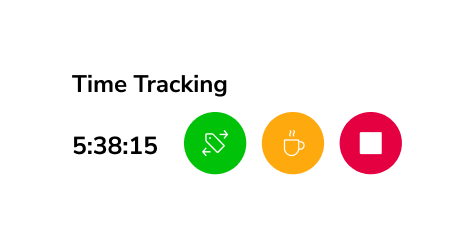You Need This in Your Next Screenshot Time Tracking Software
Key Feature in a Screenshot Time Tracker: Automated Screenshot Capture
Automated screenshot capture is a background feature in time-tracking tools that takes snapshots of an employee’s screen at set intervals. It offers visual evidence of work being done without requiring manual input and can be adjusted for frequency and working hours to respect privacy and align with work schedules.
The lack of automatic screenshot capture in some tools presents a significant challenge for verifying remote work. Manual screenshot processes rely on employers remembering to capture screens, leading to inconsistent monitoring and potential productivity misrepresentations.
This inconsistency can obscure true work patterns, hinder accurate task prioritization assessment, and inflate inefficiencies, complicating the management of remote or distributed teams and fostering trust issues due to limited and inconsistent insight into employees’ overall work habits.
Automated screenshot capture offers a consistent and unobtrusive way to document work progress. By taking snapshots at set intervals, it creates a continuous, impartial record of activity that supports fair reviews, accurate productivity analysis, and transparent remote management—without disrupting workflows or compromising employee autonomy.
See our list of The 5 Best FREE Employee Monitoring Software to compare top solutions.
Other Key Features to Look For in Screenshot Time Tracking Software
Now that we’ve discussed the KEY feature that you can’t forsake when looking for screenshot time tracking software, here are a few more features that you should definitely consider:
Multi-Screen Efficiency
Multi-screen efficiency in screenshot time-tracking software is a feature that allows the capture of screenshots from multiple monitors simultaneously. It’s especially useful for employees with multi-monitor setups, as it provides a complete picture of the work environment.
Traditional screenshot time trackers might only capture the primary screen, missing crucial work activities happening on secondary or additional monitors. This partial visibility can lead to underestimating an employee’s productivity, as tasks performed on other screens remain unrecorded.
For roles that require extensive research, data analysis, or simultaneous application use, this limitation can skew the understanding of how work hours are utilized, potentially affecting overall evaluations.
Screenshot time-tracking software with multi-screen efficiency solves this issue by ensuring a comprehensive view of employees’ work activities, no matter how many screens they use, helping combat at least one common way to get around screenshot monitoring.
It provides managers and team leaders with a full scope of the work being performed, enabling a more accurate assessment of productivity and work habits. For employees, it means their complete work effort is recognized and accounted for, promoting fairness and transparency.
Activity Tracking & Idle Detection
In screenshot time tracking software, activity tracking monitors mouse and keyboard movements to gauge employee engagement. It provides real-time insights into how actively employees are working without capturing sensitive input like keystrokes.
Idle detection complements mouse and keyboard tracking by identifying periods of inactivity. When no input is detected for a set amount of time, the system can flag the user as idle and either pause the timer or mark the time as a break. This helps distinguish between active work hours and breaks, improving the accuracy of timesheets and productivity reports.
Together, these features help employers understand work patterns, identify bottlenecks, and ensure that logged hours reflect actual work done. At the same time, transparency and adjustable settings allow companies to maintain compliance with privacy laws.
Learn what you can and cannot legally track from our Guide to Employee Monitoring in the US.
Privacy Control
Privacy control in screenshot time-tracking software allows both employees and employers to manage what is captured in screenshots and when. It can include options to blur sensitive information, set specific times for screenshots to be taken or to pause tracking during non-work-related activities.
Without privacy controls, unregulated screenshot capture can unintentionally record personal or sensitive information—like passwords, private messages, or confidential data—raising ethical concerns and creating a sense of mistrust and unease among employees. This lack of boundaries can negatively impact trust, morale, and productivity.
Implementing privacy control solves these problems by creating a more respectful and trusting relationship between employers and employees. It reassures employees that their privacy is valued and protected, even in a remote or monitored work setting.
This feature allows for transparency in how data is collected and used, giving employees control over their privacy. As a result, it builds trust, reduces resistance to time-tracking software, and fosters a positive work culture.
Offline Tracking
Offline tracking in screenshot time-tracking software is a feature that allows the software to continue recording time and capturing screenshots even when the user is not connected to the internet.
This means that the software will keep tracking work hours and activities based on the predefined settings. Once connection is re-established, the tracked time and screenshots are synchronized with the server or cloud, ensuring that all data is accurately recorded and updated in the system.
Without it, any work done without an internet connection goes unmonitored and unrecorded, which is particularly challenging for remote workers who might have unreliable internet connections or for those who travel frequently and work in transit.
As a result, there’s a gap in productivity records, making it difficult for employers to get a full picture. Employees, on the other hand, may not get credit for all the hours they’ve worked, leading to discrepancies in time-tracking and potentially affecting evaluations or pay.
Offline tracking solves these issues by ensuring continuous monitoring of work activities, regardless of internet availability.
Learn how tracking time without an internet connection works in Jibble.
Conclusion
In conclusion, when selecting screenshot time-tracking software, it is imperative to consider essential features such as automated screenshot capture, multi-screen capability, activity tracking, privacy controls, and offline tracking functionality.
These features are indispensable for enhancing productivity, ensuring accuracy in time recording, and maintaining privacy and flexibility in various work environments, thereby supporting a diverse and dynamic workforce.
Notably, Jibble offers all of these features at no cost, making it an exceptional choice for those seeking a comprehensive time-tracking solution without additional financial investment.
Important Cautionary Note
When making this above guide, we have tried to make it accurate, but we do not give any guarantee that the information provided is correct or up-to-date. We therefore strongly advise you to seek advice from qualified professionals before acting on any information provided in this guide. We do not accept any liability for any damages or risks incurred for the use of this guide.
Related Articles:
You Need This in Your Next Time Tracking Software
Pros and Cons of Employee Monitoring
How Far Can Employee Monitoring Go in the US
You Need This in Your Next GPS Time Tracker
Employee Monitoring Evasion Tactics in the Age of Remote Work


